Answered step by step
Verified Expert Solution
Question
1 Approved Answer
The New York Times and Jayson Blair (A) All the News That's Fit To Print? On June 6, 2003, The New York Times Executive
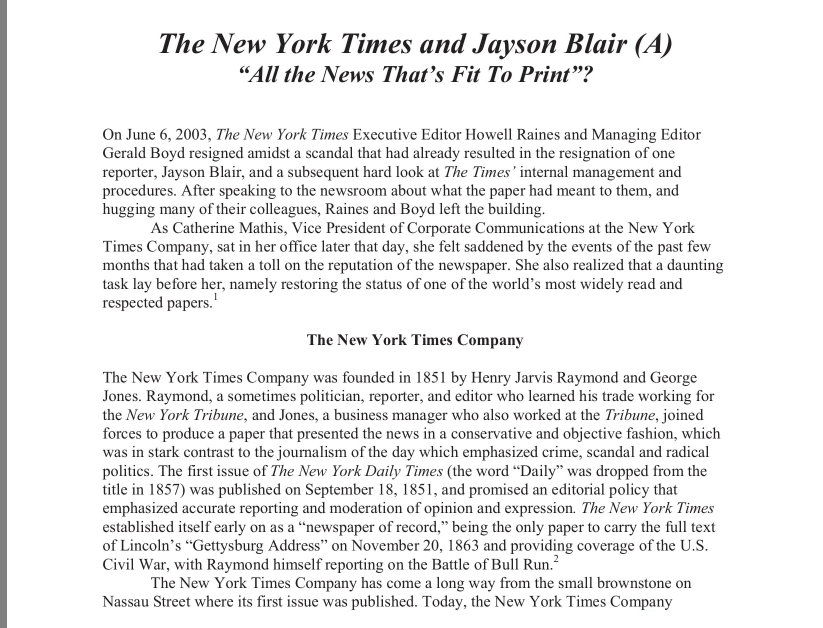
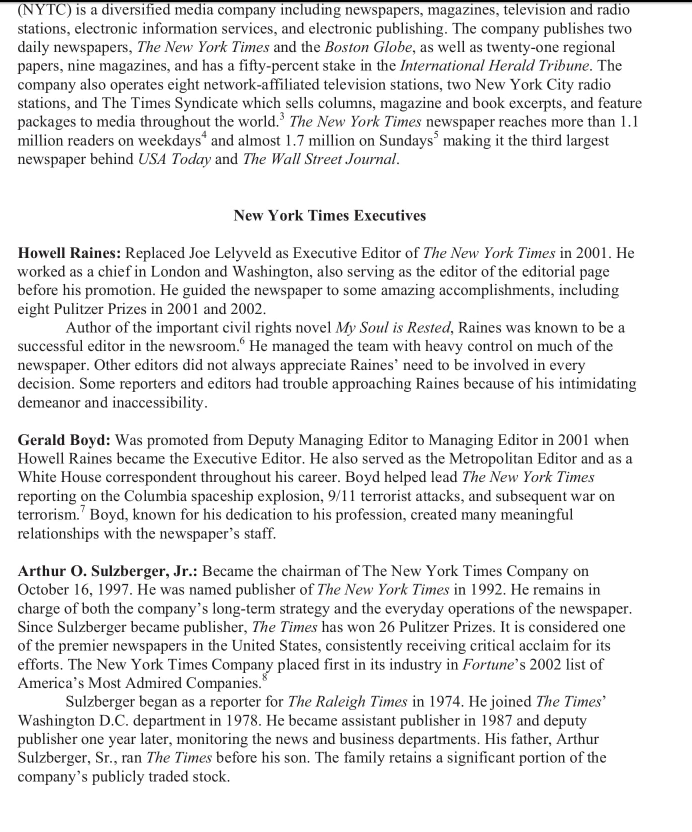
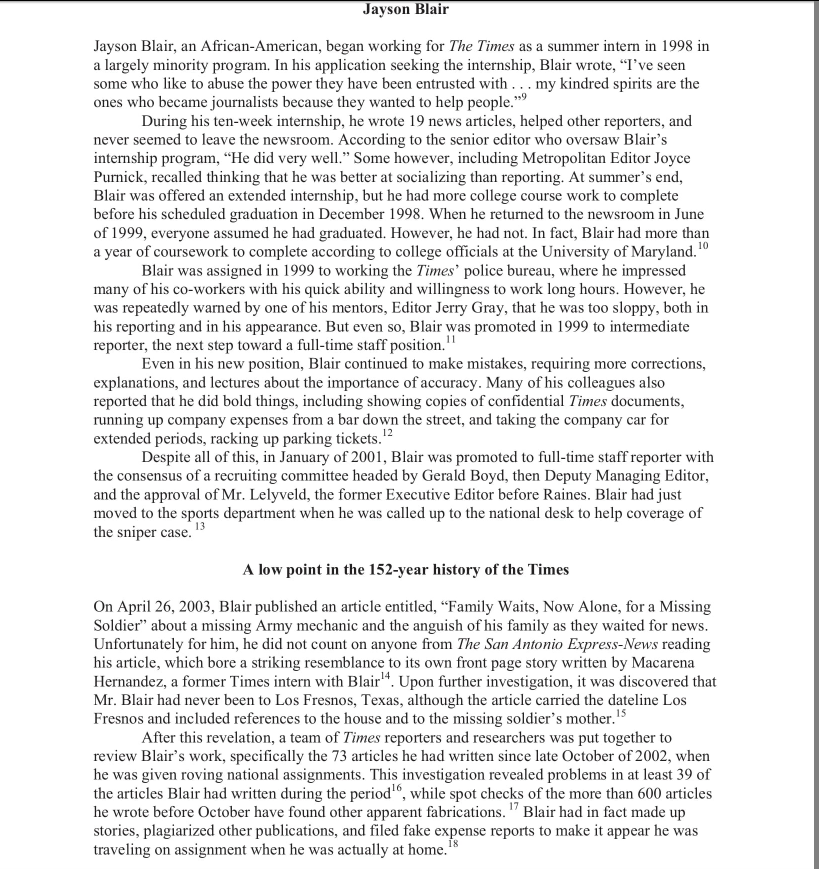
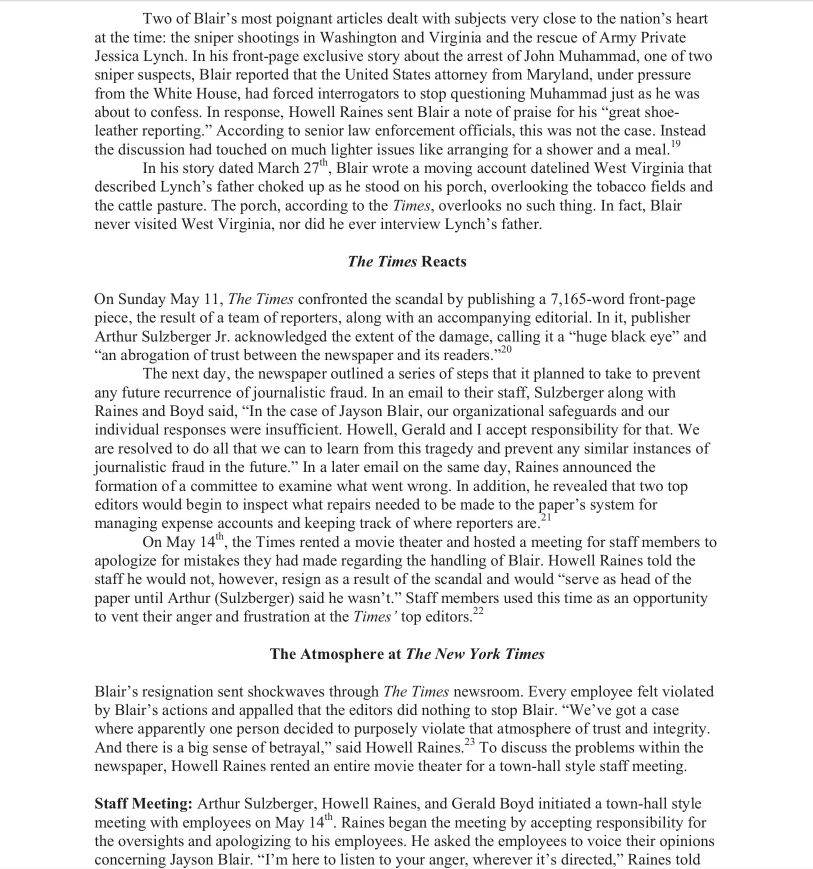
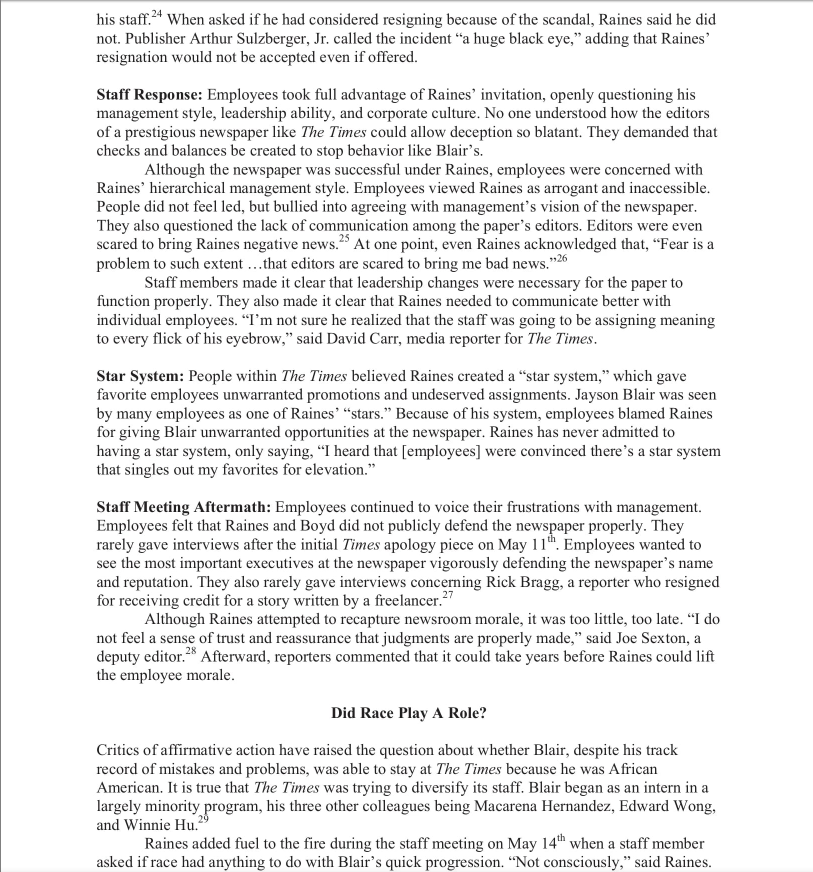
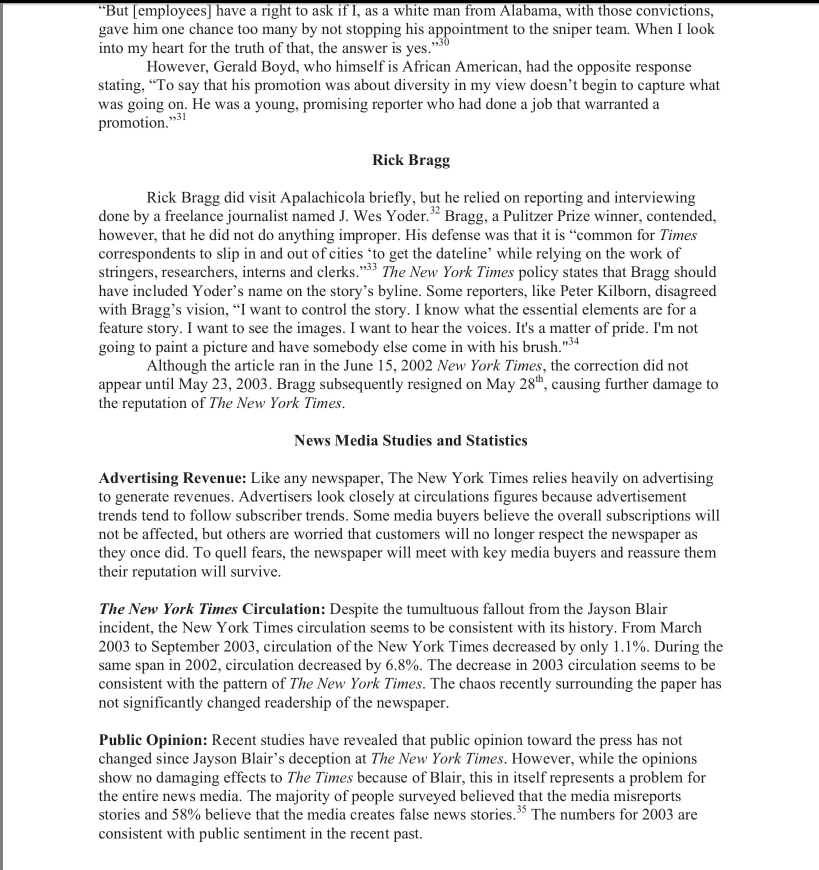
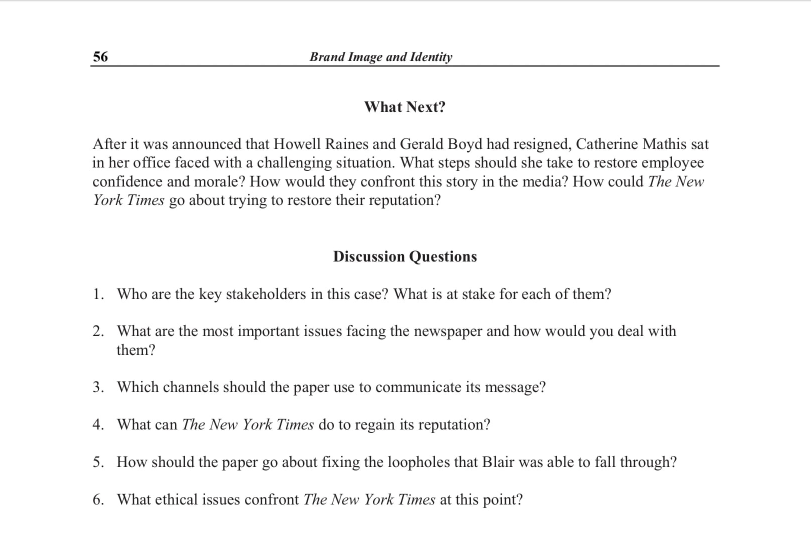
The New York Times and Jayson Blair (A) "All the News That's Fit To Print"? On June 6, 2003, The New York Times Executive Editor Howell Raines and Managing Editor Gerald Boyd resigned amidst a scandal that had already resulted in the resignation of one reporter, Jayson Blair, and a subsequent hard look at The Times' internal management and procedures. After speaking to the newsroom about what the paper had meant to them, and hugging many of their colleagues, Raines and Boyd left the building. As Catherine Mathis, Vice President of Corporate Communications at the New York Times Company, sat in her office later that day, she felt saddened by the events of the past few months that had taken a toll on the reputation of the newspaper. She also realized that a daunting task lay before her, namely restoring the status of one of the world's most widely read and respected papers. The New York Times Company The New York Times Company was founded in 1851 by Henry Jarvis Raymond and George Jones. Raymond, a sometimes politician, reporter, and editor who learned his trade working for the New York Tribune, and Jones, a business manager who also worked at the Tribune, joined forces to produce a paper that presented the news in a conservative and objective fashion, which was in stark contrast to the journalism of the day which emphasized crime, scandal and radical politics. The first issue of The New York Daily Times (the word "Daily" was dropped from the title in 1857) was published on September 18, 1851, and promised an editorial policy that emphasized accurate reporting and moderation of opinion and expression. The New York Times established itself early on as a "newspaper of record," being the only paper to carry the full text of Lincoln's "Gettysburg Address" on November 20, 1863 and providing coverage of the U.S. Civil War, with Raymond himself reporting on the Battle of Bull Run. The New York Times Company has come a long way from the small brownstone on Nassau Street where its first issue was published. Today, the New York Times Company (NYTC) is a diversified media company including newspapers, magazines, television and radio stations, electronic information services, and electronic publishing. The company publishes two daily newspapers, The New York Times and the Boston Globe, as well as twenty-one regional papers, nine magazines, and has a fifty-percent stake in the International Herald Tribune. The company also operates eight network-affiliated television stations, two New York City radio stations, and The Times Syndicate which sells columns, magazine and book excerpts, and feature packages to media throughout the world. The New York Times newspaper reaches more than 1.1 million readers on weekdays and almost 1.7 million on Sundays making it the third largest newspaper behind USA Today and The Wall Street Journal. New York Times Executives Howell Raines: Replaced Joe Lelyveld as Executive Editor of The New York Times in 2001. He worked as a chief in London and Washington, also serving as the editor of the editorial page before his promotion. He guided the newspaper to some amazing accomplishments, including eight Pulitzer Prizes in 2001 and 2002. Author of the important civil rights novel My Soul is Rested, Raines was known to be a successful editor in the newsroom. He managed the team with heavy control on much of the newspaper. Other editors did not always appreciate Raines' need to be involved in every decision. Some reporters and editors had trouble approaching Raines because of his intimidating demeanor and inaccessibility. Gerald Boyd: Was promoted from Deputy Managing Editor to Managing Editor in 2001 when Howell Raines became the Executive Editor. He also served as the Metropolitan Editor and as a White House correspondent throughout his career. Boyd helped lead The New York Times reporting on the Columbia spaceship explosion, 9/11 terrorist attacks, and subsequent war on terrorism. Boyd, known for his dedication to his profession, created many meaningful relationships with the newspaper's staff. Arthur O. Sulzberger, Jr.: Became the chairman of The New York Times Company on October 16, 1997. He was named publisher of The New York Times in 1992. He remains in charge of both the company's long-term strategy and the everyday operations of the newspaper. Since Sulzberger became publisher, The Times has won 26 Pulitzer Prizes. It is considered one of the premier newspapers in the United States, consistently receiving critical acclaim for its efforts. The New York Times Company placed first in its industry in Fortune's 2002 list of America's Most Admired Companies. Sulzberger began as a reporter for The Raleigh Times in 1974. He joined The Times' Washington D.C. department in 1978. He became assistant publisher in 1987 and deputy publisher one year later, monitoring the news and business departments. His father, Arthur Sulzberger, Sr., ran The Times before his son. The family retains a significant portion of the company's publicly traded stock. Jayson Blair Jayson Blair, an African-American, began working for The Times as a summer intern in 1998 in a largely minority program. In his application seeking the internship, Blair wrote, "I've seen some who like to abuse the power they have been entrusted with... my kindred spirits are the ones who became journalists because they wanted to help people." During his ten-week internship, he wrote 19 news articles, helped other reporters, and never seemed to leave the newsroom. According to the senior editor who oversaw Blair's internship program, "He did very well." Some however, including Metropolitan Editor Joyce Purnick, recalled thinking that he was better at socializing than reporting. At summer's end, Blair was offered an extended internship, but he had more college course work to complete before his scheduled graduation in December 1998. When he returned to the newsroom in June of 1999, everyone assumed he had graduated. However, he had not. In fact, Blair had more than a year of coursework to complete according to college officials at the University of Maryland. 10 Blair was assigned in 1999 to working the Times' police bureau, where he impressed many of his co-workers with his quick ability and willingness to work long hours. However, he was repeatedly warned by one of his mentors, Editor Jerry Gray, that he was too sloppy, both in his reporting and in his appearance. But even so, Blair was promoted in 1999 to intermediate reporter, the next step toward a full-time staff position." Even in his new position, Blair continued to make mistakes, requiring more corrections, explanations, and lectures about the importance of accuracy. Many of his colleagues also reported that he did bold things, including showing copies of confidential Times documents, running up company expenses from a bar down the street, and taking the company car for extended periods, racking up parking tickets. Despite all of this, in January of 2001, Blair was promoted to full-time staff reporter with the consensus of a recruiting committee headed by Gerald Boyd, then Deputy Managing Editor, and the approval of Mr. Lelyveld, the former Executive Editor before Raines. Blair had just moved to the sports department when he was called up to the national desk to help coverage of the sniper case. 3 A low point in the 152-year history of the Times On April 26, 2003, Blair published an article entitled, "Family Waits, Now Alone, for a Missing Soldier" about a missing Army mechanic and the anguish of his family as they waited for news. Unfortunately for him, he did not count on anyone from The San Antonio Express-News reading his article, which bore a striking resemblance to its own front page story written by Macarena Hernandez, a former Times intern with Blair4. Upon further investigation, it was discovered that Mr. Blair had never been to Los Fresnos, Texas, although the article carried the dateline Los Fresnos and included references to the house and to the missing soldier's mother.5 After this revelation, a team of Times reporters and researchers was put together to review Blair's work, specifically the 73 articles he had written since late October of 2002, when he was given roving national assignments. This investigation revealed problems in at least 39 of the articles Blair had written during the period6, while spot checks of the more than 600 articles he wrote before October have found other apparent fabrications. 17 Blair had in fact made up stories, plagiarized other publications, and filed fake expense reports to make it appear he was traveling on assignment when he was actually at home." 18 Two of Blair's most poignant articles dealt with subjects very close to the nation's heart at the time: the sniper shootings in Washington and Virginia and the rescue of Army Private Jessica Lynch. In his front-page exclusive story about the arrest of John Muhammad, one of two sniper suspects, Blair reported that the United States attorney from Maryland, under pressure from the White House, had forced interrogators to stop questioning Muhammad just as he was about to confess. In response, Howell Raines sent Blair a note of praise for his "great shoe- leather reporting." According to senior law enforcement officials, this was not the case. Instead the discussion had touched on much lighter issues like arranging for a shower and a meal. In his story dated March 27th, Blair wrote a moving account datelined West Virginia that described Lynch's father choked up as he stood on his porch, overlooking the tobacco fields and the cattle pasture. The porch, according to the Times, overlooks no such thing. In fact, Blair never visited West Virginia, nor did he ever interview Lynch's father. The Times Reacts On Sunday May 11, The Times confronted the scandal by publishing a 7,165-word front-page piece, the result of a team of reporters, along with an accompanying editorial. In it, publisher Arthur Sulzberger Jr. acknowledged the extent of the damage, calling it a "huge black eye" and "an abrogation of trust between the newspaper and its readers."20 The next day, the newspaper outlined a series of steps that it planned to take to prevent any future recurrence of journalistic fraud. In an email to their staff, Sulzberger along with Raines and Boyd said, "In the case of Jayson Blair, our organizational safeguards and our individual responses were insufficient. Howell, Gerald and I accept responsibility for that. We are resolved to do all that we can to learn from this tragedy and prevent any similar instances of journalistic fraud in the future." In a later email on the same day, Raines announced the formation of a committee to examine what went wrong. In addition, he revealed that two top editors would begin to inspect what repairs needed to be made to the paper's system for managing expense accounts and keeping track of where reporters are. On May 14th, the Times rented a movie theater and hosted a meeting for staff members to apologize for mistakes they had made regarding the handling of Blair. Howell Raines told the staff he would not, however, resign as a result of the scandal and would "serve as head of the paper until Arthur (Sulzberger) said he wasn't." Staff members used this time as an opportunity to vent their anger and frustration at the Times' top editors. The Atmosphere at The New York Times Blair's resignation sent shockwaves through The Times newsroom. Every employee felt violated by Blair's actions and appalled that the editors did nothing to stop Blair. "We've got a case where apparently one person decided to purposely violate that atmosphere of trust and integrity. And there is a big sense of betrayal," said Howell Raines.23 To discuss the problems within the newspaper, Howell Raines rented an entire movie theater for a town-hall style staff meeting. Staff Meeting: Arthur Sulzberger, Howell Raines, and Gerald Boyd initiated a town-hall style meeting with employees on May 14th. Raines began the meeting by accepting responsibility for the oversights and apologizing to his employees. He asked the employees to voice their opinions concerning Jayson Blair. "I'm here to listen to your anger, wherever it's directed," Raines told his staff.24 When asked if he had considered resigning because of the scandal, Raines said he did not. Publisher Arthur Sulzberger, Jr. called the incident "a huge black eye," adding that Raines' resignation would not be accepted even if offered. Staff Response: Employees took full advantage of Raines' invitation, openly questioning his management style, leadership ability, and corporate culture. No one understood how the editors of a prestigious newspaper like The Times could allow deception so blatant. They demanded that checks and balances be created to stop behavior like Blair's. Although the newspaper was successful under Raines, employees were concerned with Raines' hierarchical management style. Employees viewed Raines as arrogant and inaccessible. People did not feel led, but bullied into agreeing with management's vision of the newspaper. They also questioned the lack of communication among the paper's editors. Editors were even scared to bring Raines negative news.25 At one point, even Raines acknowledged that, "Fear is a problem to such extent ...that editors are scared to bring me bad news." "26 Staff members made it clear that leadership changes were necessary for the paper to function properly. They also made it clear that Raines needed to communicate better with individual employees. "I'm not sure he realized that the staff was going to be assigning meaning to every flick of his eyebrow," said David Carr, media reporter for The Times. Star System: People within The Times believed Raines created a "star system, which gave favorite employees unwarranted promotions and undeserved assignments. Jayson Blair was seen by many employees as one of Raines" "stars." Because of his system, employees blamed Raines for giving Blair unwarranted opportunities at the newspaper. Raines has never admitted to having a star system, only saying, "I heard that [employees] were convinced there's a star system that singles out my favorites for elevation." Staff Meeting Aftermath: Employees continued to voice their frustrations with management. Employees felt that Raines and Boyd did not publicly defend the newspaper properly. They rarely gave interviews after the initial Times apology piece on May 11th. Employees wanted to see the most important executives at the newspaper vigorously defending the newspaper's name and reputation. They also rarely gave interviews concerning Rick Bragg, a reporter who resigned for receiving credit for a story written by a freelancer.7 Although Raines attempted to recapture newsroom morale, it was too little, too late. "I do not feel a sense of trust and reassurance that judgments are properly made," said Joe Sexton, a deputy editor. Afterward, reporters commented that it could take years before Raines could lift the employee morale. 28 Did Race Play A Role? Critics of affirmative action have raised the question about whether Blair, despite his track record of mistakes and problems, was able to stay at The Times because he was African American. It is true that The Times was trying to diversify its staff. Blair began as an intern in a largely minority program, his three other colleagues being Macarena Hernandez, Edward Wong, and Winnie Hu. Raines added fuel to the fire during the staff meeting on May 14th when a staff member asked if race had anything to do with Blair's quick progression. "Not consciously," said Raines. "But [employees] have a right to ask if I, as a white man from Alabama, with those convictions, gave him one chance too many by not stopping his appointment to the sniper team. When I look into my heart for the truth of that, the answer is yes." 1.930 However, Gerald Boyd, who himself is African American, had the opposite response stating, "To say that his promotion was about diversity in my view doesn't begin to capture what was going on. He was a young, promising reporter who had done a job that warranted a promotion."1 Rick Bragg Rick Bragg did visit Apalachicola briefly, but he relied on reporting and interviewing done by a freelance journalist named J. Wes Yoder. 32 Bragg, a Pulitzer Prize winner, contended, however, that he did not do anything improper. His defense was that it is "common for Times correspondents to slip in and out of cities to get the dateline' while relying on the work of stringers, researchers, interns and clerks."33 The New York Times policy states that Bragg should have included Yoder's name on the story's byline. Some reporters, like Peter Kilborn, disagreed with Bragg's vision, "I want to control the story. I know what the essential elements are for a feature story. I want to see the images. I want to hear the voices. It's a matter of pride. I'm not going to paint a picture and have somebody else come in with his brush."4 Although the article ran in the June 15, 2002 New York Times, the correction did not appear until May 23, 2003. Bragg subsequently resigned on May 28th, causing further damage to the reputation of The New York Times. News Media Studies and Statistics Advertising Revenue: Like any newspaper, The New York Times relies heavily on advertising to generate revenues. Advertisers look closely at circulations figures because advertisement trends tend to follow subscriber trends. Some media buyers believe the overall subscriptions will not be affected, but others are worried that customers will no longer respect the newspaper as they once did. To quell fears, the newspaper will meet with key media buyers and reassure them their reputation will survive. The New York Times Circulation: Despite the tumultuous fallout from the Jayson Blair incident, the New York Times circulation seems to be consistent with its history. From March 2003 to September 2003, circulation of the New York Times decreased by only 1.1%. During the same span in 2002, circulation decreased by 6.8%. The decrease in 2003 circulation seems to be consistent with the pattern of The New York Times. The chaos recently surrounding the paper has not significantly changed readership of the newspaper. Public Opinion: Recent studies have revealed that public opinion toward the press has not changed since Jayson Blair's deception at The New York Times. However, while the opinions show no damaging effects to The Times because of Blair, this in itself represents a problem for the entire news media. The majority of people surveyed believed that the media misreports stories and 58% believe that the media creates false news stories.35 The numbers for 2003 are consistent with public sentiment in the recent past. 56 Brand Image and Identity What Next? After it was announced that Howell Raines and Gerald Boyd had resigned, Catherine Mathis sat in her office faced with a challenging situation. What steps should she take to restore employee confidence and morale? How would they confront this story in the media? How could The New York Times go about trying to restore their reputation? Discussion Questions 1. Who are the key stakeholders in this case? What is at stake for each of them? 2. What are the most important issues facing the newspaper and how would you deal with them? 3. Which channels should the paper use to communicate its message? 4. What can The New York Times do to regain its reputation? 5. How should the paper go about fixing the loopholes that Blair was able to fall through? 6. What ethical issues confront The New York Times at this point?
Step by Step Solution
★★★★★
3.42 Rating (161 Votes )
There are 3 Steps involved in it
Step: 1

Get Instant Access to Expert-Tailored Solutions
See step-by-step solutions with expert insights and AI powered tools for academic success
Step: 2

Step: 3

Ace Your Homework with AI
Get the answers you need in no time with our AI-driven, step-by-step assistance
Get Started


